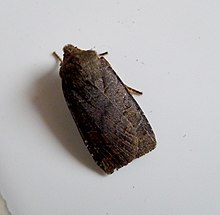| Southern chestnut | |
|---|---|

| |
| Scientific classification | |
| Domain: | Eukaryota |
| Kingdom: | Animalia |
| Phylum: | Arthropoda |
| Class: | Insecta |
| Order: | Lepidoptera |
| Superfamily: | Noctuoidea |
| Family: | Noctuidae |
| Genus: | Agrochola |
| Species: | A. haematidea |
| Binomial name | |
| Agrochola haematidea (Duponchel, 1827) | |
Agrochola haematidea, the southern chestnut, is a moth of the family Noctuidae. The species was first described by Philogène Auguste Joseph Duponchel in 1827. It is found in the southern parts of Europe (including the southernmost parts of Great Britain).
Technical description and variation
For a key to the terms used, see Glossary of entomology terms.A. haematidea Dup. (37 d). Forewing smooth, deep chestnut brown, darker along inner margin, paler in terminal area; cell and median shade deeper chestnut; lines indistinct, the outer double; submarginal line preceded by a row of small black marks and on costa by a blackish blotch; stigmata small, undefined, pale; the orbicular oblique nearly touching reniform at bottom; hindwing fuscous, the fringe pinkish. The forewing has the apex acute and termen oblique.
The wingspan is 32–38 mm.
Biology
The moth flies from October to November depending on the location. The larvae feed on Erica cinerea and Erica tetralix.
Notes
In England it was first discovered by Professor Colin Smith of Cambridge University.
References
- Warren. W. in Seitz, A. Ed., 1914 Die Großschmetterlinge der Erde, Verlag Alfred Kernen, Stuttgart Band 3: Abt. 1, Die Großschmetterlinge des palaearktischen Faunengebietes, Die palaearktischen eulenartigen Nachtfalter, 1914
 This article incorporates text from this source, which is in the public domain.
This article incorporates text from this source, which is in the public domain.
External links
- Kimber, Ian. "73.191 BF2264a Southern Chestnut Agrochola haematidea (Duponchel, 1827)". UKMoths. Retrieved 21 January 2021.
- Fauna Europaea
- "09572 Agrochola haematidea (Duponchel, [1828])". Lepiforum e. V. Retrieved 21 January 2021.
| Taxon identifiers | |
|---|---|
| Agrochola haematidea |
|
This article is a stub. You can help Misplaced Pages by expanding it. |